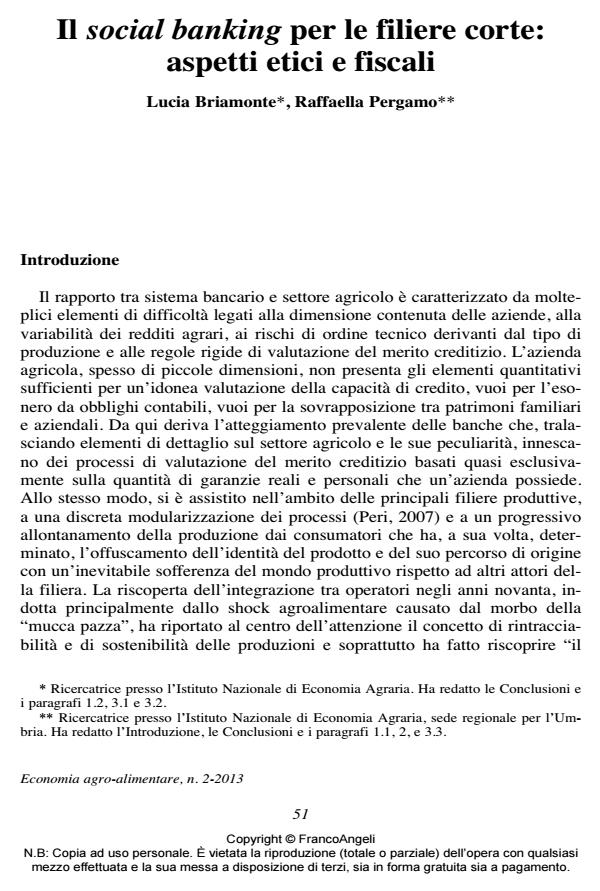Social banking for short chains: ethical and fiscal aspects
Journal title ECONOMIA AGRO-ALIMENTARE
Author/s Lucia Briamonte, Raffaella Pergamo
Publishing Year 2013 Issue 2013/2
Language Italian Pages 22 P. 51-72 File size 128 KB
DOI 10.3280/ECAG2013-002004
DOI is like a bar code for intellectual property: to have more infomation
click here
Below, you can see the article first page
If you want to buy this article in PDF format, you can do it, following the instructions to buy download credits

FrancoAngeli is member of Publishers International Linking Association, Inc (PILA), a not-for-profit association which run the CrossRef service enabling links to and from online scholarly content.
The relationship between the banking system and the agricultural sector ismarked by several difficulties related to firm size, variability in agriculturalincomes, technical risks and strict evaluation rules for creditworthiness. On theother hand, a progressive distancing of production from consumers is observedwithin the main production chains, with weakening of product identity and ofproduction with respect to other actors in the chain. The rediscovery, in the nineties,of integration among operators has brought under the spotlight the concepts oftraceability and sustainability of productions and the "principle of proximity",making purchase directly, from the producer one of the consumer’s main objectives.Widespread awareness of this factor has contributed to an increase in localproduction and consumption circuits and has awoken interest in some banks, whichhave set out social banking instruments for farming concerns which face difficultiesin accessing ordinary bank loans.The analysis refers to Toscana, a regional context in which short chain examplescoexist with a particular microcredit system. In particular, the aim is evaluatingapproaches to social banking adopted by short chains and identifying the mainentrepreneurial advantages and socio-economic results.The methodology, therefore, took as reference the short chain entrepreneurialforms found in Tuscany and carried out focused interviews with Banca Etica andConsorzio Fidi Toscana in order to comprehend their vision of the overall businessmodel, even though it may not be strictly agricultural. The aim was also to identifyspecial needs and expectations as expressed by the short chain entrepreneurs as wellas their motivation in changing the boundaries of their area of operation. The finalaim of the analysis was to understand what banking services are available and howthey might help in establishing short supply-chains and making them morewidespreads in their region.The starting point was to identify the main manifestations of existing shortsupply-chain operations (direct sales to consumers, solidarity purchase groupsamongst producers and markets). The main characteristics of banking servicesoffered to them were also investigated. Were they responding to the idea itself ofsocial banking for food processing and not merely offering of banking services tomarginal customers? Was this a targeted approach specially adopted for the shortsupply-chain market: a segment characterized by low levels of income and by theneed for innovative financial solutions which are, at the same time, both accessibleand inexpensive. The results enabled us to highlight the key role of social banking inlocal production and consumption circuits in terms of both start-up activities and thesupply of technical assistance and training services. Moreover, they indicated thatshort supply-chain operations are not only associated with shorter distances, but alsowith greater transparency and responsibility in production-consumption relationships.
Keywords: Social banking, short chains, microfinance, microcredit
Jel codes: Q13, Q14, R51
Lucia Briamonte, Raffaella Pergamo, Il social banking per le filiere corte: aspetti etici e fiscali in "ECONOMIA AGRO-ALIMENTARE" 2/2013, pp 51-72, DOI: 10.3280/ECAG2013-002004